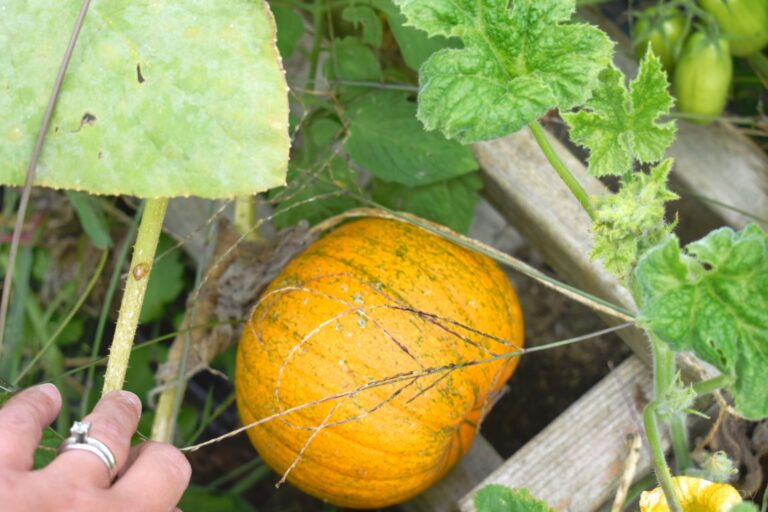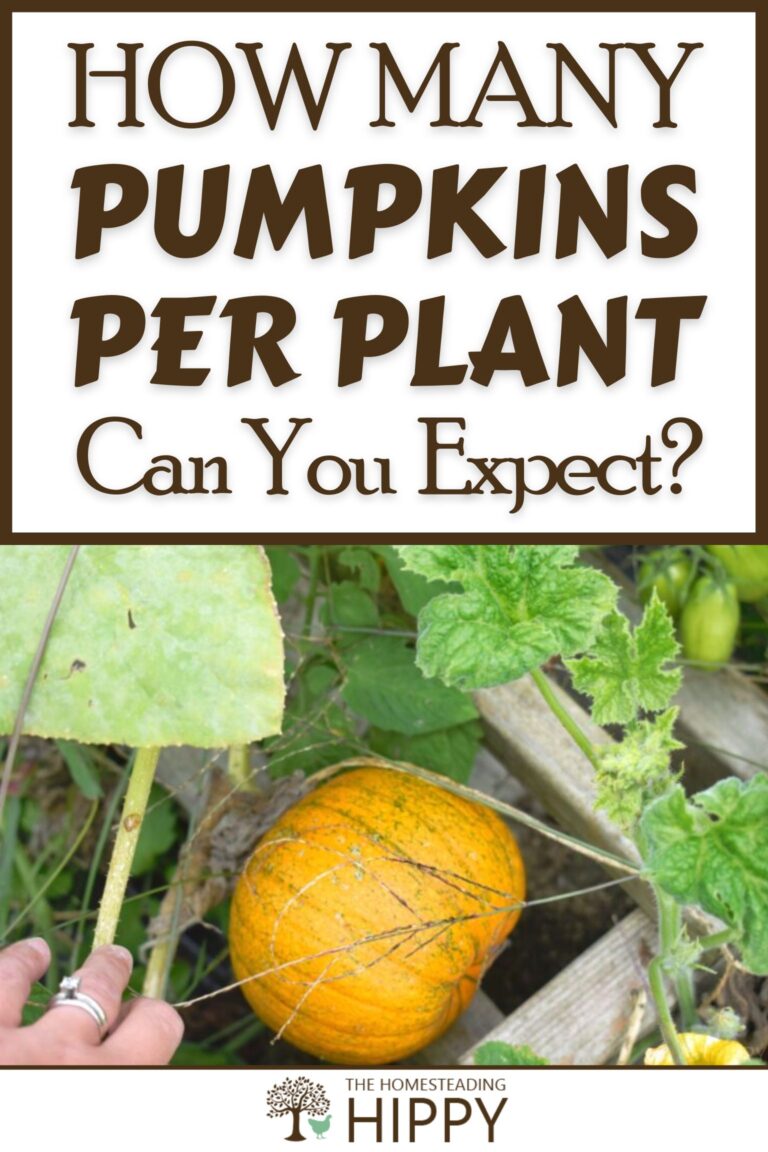Halloween is coming up, and that means it’s time to get your pumpkin pie recipes ready. But how many pumpkins do you need to make all those pies? This year, try growing your own pumpkins and find out for yourself!

If you’re awaiting a harvest – or perhaps planning ahead for next year’s planting – you might be wondering how many pumpkins you can reasonably expect to get.
An average pumpkin plant produces 2 to 5 pumpkins. Smaller varieties may produce up to 12 pumpkins.
Larger varieties should be pruned and pinched to only produce one pumpkin (so the plant can direct all of its energy to that single fruit).
There are other factors that influence how many pumpkins your plants will produce. We’ll take a close look at all of them in this post, so keep reading to learn more!
How Many Pumpkins Per Plant Can You Reasonably Expect to Get?
Unfortunately, there is no definitive answer to this question, as the number of pumpkins produced by a plant can vary widely depending on a number of factors.
For instance, the size of the pumpkin variety you are growing can impact the number of fruits produced. Larger varieties, like white pumpkins, tend to produce fewer pumpkins than smaller ones.
Additionally, environmental conditions such as temperature and rainfall can also affect yields. With that said, most pumpkin plants will produce between two and four fruits.
However, some plants may produce more, while others may produce fewer. Some miniature varieties of pumpkins can produce a dozen plants per vine!
The best way to ensure a good pumpkin harvest is to start with a healthy plant and provide it with plenty of water and sunlight.
With the right conditions, you should be able to get a decent number of pumpkins from each plant.
What Factors Impact How Many Pumpkins You Get?
There are many factors that impact how many pumpkins a farmer can grow in a season. Let’s take a closer look.
Climate and Location
If you’re hoping for a bumper crop of pumpkins this year, you might want to pay attention to the weather. Believe it or not, the climate has a big impact on how many pumpkins a farmer can grow.
Pumpkins are a warm-weather crop, so they need long days and warm nights to thrive. In cooler climates, the growing season is simply too short for pumpkins to mature.
And in areas with very hot summers, the heat can stress the plants and cause the fruits to develop problems like blossom end rot.
Spacing
When it comes to pumpkin production, spacing is everything. Pumpkins are large, vining plants that need plenty of room to spread out.
If pumpkins are too closely spaced, they will compete for resources and sunlight, which can reduce the size and number of fruits. In addition, overcrowded pumpkin plants are more susceptible to disease.
Amount of Sun
As any gardener knows, the amount of sunlight a plant receives can have a big impact on its growth. Pumpkins are no exception.
Plants that receive more than eight hours of sunlight per day tend to produce more fruit, while those that receive less sun may produce smaller fruits or no fruit at all.
In addition, the amount of sunlight a pumpkin plant receives can also impact the color of its fruit.
Pumpkins that are grown in full sun tend to be brighter orange than those grown in partial shade.
As a result, gardeners who want to maximize their pumpkin yield should choose a location that receives plenty of sunshine.
Variety
The Jack B, or JBL, pumpkin is a miniature variety that can yield up to 12 pumpkins per plant.
These pumpkins are incredibly small, often fitting comfortably in the palm of your hand.
In contrast, the Kratos Hybrid Pumpkin grows just one pumpkin per plant, but this pumpkin can reach 14 inches in diameter and weigh up to 35 pounds.
The Big Max also produces fewer pumpkins per plant, but they’re large – up to 100 lbs in some cases!
The size of the pumpkin definitely impacts how many pumpkins you can expect to get from each plant. The more pumpkins, the smaller they will be.
How Much Space Does a Pumpkin Plant Need?
This is an important question for anyone looking to grow pumpkins, as the amount of space can have a significant impact on the size and quantity of the harvest.
Again, it comes down to the conditions mentioned above, with the most important variable being the variety of pumpkins you are growing.
Large or giant pumpkins need around 70 square feet (6.5 square meters), in some cases, to reach their fullest potential. Smaller varieties require less space – usually only five feet between the plants and four plants in the rows.
There’s no single formula to guarantee success. However, proper spacing is always going to be essential to a bountiful harvest.
When pumpkins are overcrowded, they stop growing and remain the same size. This is because each pumpkin is competing with the others for space, sunlight, water, and nutrients.
As a result, the pumpkins that are buried deepest in the pumpkin patch often don’t receive enough of these resources to continue growing.
Overcrowding can also lead to disease, as fungi and bacteria have an easier time spreading when pumpkins are packed closely together.
If you plant pumpkin seeds and have multiple plants spring up out of the same planting hole, just thin them. It’s as easy as that.
Make sure you check the labels on the back of your seed packet. These instructions will tell you exactly how much space to give your pumpkin plants to keep them healthy.
What Can I Do to Increase the Number of Pumpkins a Plant Produces?
Though they may seem like a difficult plant to grow, with a little bit of care and attention, it is possible to produce a healthy crop of pumpkins.
One way to encourage fruit production is to thin out the plants once they have reached about six inches tall. This allows the remaining plants more room to grow and produces larger fruits.
It is also important to water regularly, especially during dry spells. Pumpkins need about an inch of water per week, so be sure to provide a consistent supply.
Lastly, adding a thin layer of compost around the base of the plant can help to provide essential nutrients.
Why Hasn’t My Pumpkin Plant Produced Any Pumpkins?
If you have been waiting patiently for your pumpkin plant to produce fruit, only to be disappointed, there are a few possible reasons why. One reason could be that your plant is not getting enough sunlight.
Another possibility is that your plant is not getting enough water. Pumpkins need about an inch of water per week, so make sure to keep an eye on the moisture levels in your garden.
It is also important to make sure that your plant is getting enough nutrients. Add a handful of compost or organic fertilizer to the soil around your pumpkin plant every month or so.
Another issue is pollination. If you’re not sure whether your pumpkin plant has been pollinated, there are a few things to look for.
The first is flowers. Pumpkin plants will produce both male and female flowers, and the female flowers will have a small swelling at the base of the flower.
If you see flowers on your pumpkin plant that are then developing into small pumpkins, it’s a good sign that pollination is happening.
If flowers appear and you wait weeks without seeing results, you may need to hand-pollinate your pumpkin plants.
What’s the Best Target Goal Per Pumpkin Plant?
While you may think that the more pumpkins per plant, the better, that is not always the case.
If you are hoping to grow giant pumpkins, such as Dill’s Atlantic Giant Pumpkin, it is best to focus on growing a single pumpkin per plant. This will allow the plant to dedicate all of its resources to that one pumpkin.
However, if your goal is to grow normal or larger-sized pumpkins, such as Cinderella Pumpkins, you should aim for at least 2 pumpkins per plant.
The general rule of thumb is 3 pumpkins per plant. Any more than that and the vines will start to get crowded and will not have enough room to grow properly.
When determining how many pumpkins to aim for per plant, keep in mind what your ultimate goal is.
How Many Pumpkins Will 1 Acre Produce?
One acre of land can yield a surprisingly large number of pumpkins. Depending on the variety of pumpkins and the conditions of the growing season, an acre of land can produce anywhere from 800 to 5,000 pumpkins.
This wide range is, again, due to a number of factors, including the amount of rainfall, the amount of sunlight, and the soil composition.
In general, however, an acre of land can provide plenty of pumpkins for a family to enjoy all autumn long.
Whether used for carving jack-o-lanterns or baking pies, pumpkins are a staple of fall celebrations. So if you’re wondering how many pumpkins 1 acre will yield, the answer is: quite a few!
Final Thoughts
Pumpkin plants are a great way to get into gardening. Not only are they easy to grow, but they also produce an abundance of pumpkins that can be used for decorations, pies, and other recipes.
By following these tips and having reasonable expectations of how much your plants will produce, you should be able to increase your pumpkin yield significantly and enjoy lots of delicious home-grown pumpkins this fall!


Rebekah is a full-time homesteader. On her 22 acres, she raises chickens, sheep, and bees, not to mention she grows a wide variety of veggies. She has a huge greenhouse and does lots of DIY projects with her husband in her ever-growing homesteading endeavor. Learn more about Rebekah here.
